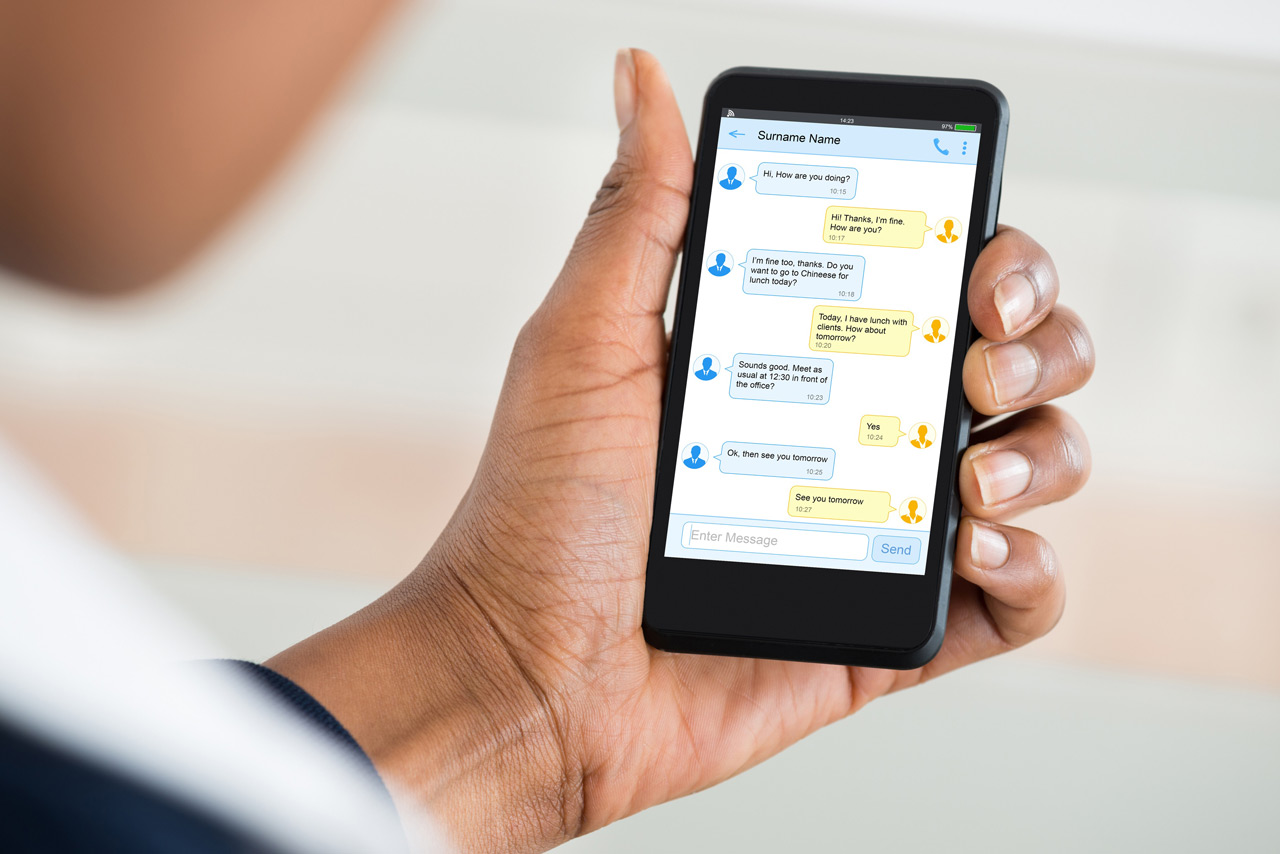Editor’s Note: This article first appeared in Court News Ohio, a service of the Ohio Supreme Court and Ohio Government Telecommunications.
Technology pervades our lives. We stay connected on smartphones, research everything online, talk to far-away relatives over video, check apps for directions. Courts in Ohio are exploring how to leverage these advances to better serve the public.
Technology has streamlined the experience for people involved in cases at the Hamilton County Domestic Relations Court. The court operates with three judges — Administrative Judge Jon Sieve, Judge Amy Searcy, and Judge Susan Tolbert — and 12 magistrates. Typically, attorneys and litigants wait in a large atrium near the magistrates’ hearing rooms. For years, magistrates had to step into the waiting area and loudly announce the parties’ names when a hearing was about to begin, said Court Administrator Lisa Gorrasi. Court staff found that the procedure often made individuals uncomfortable, and attorneys and litigants had to remain very close to hearing rooms.
The judges asked the court administrators to develop a better approach that assured the privacy of the parties and was more dignified, Gorrasi said. One early thought was something like the buzzing pagers that restaurants use. Instead, they opted for a text message notification system, developed by a staff programmer and the court’s software developer, and implemented earlier this year at no extra expense to the court.

Text messages alert parties that their court hearing is about to begin and provide the hearing room location.
Text messages alert parties that their court hearing is about to begin and provide the hearing room location. When filing a case or reporting to court now, the parties and their attorneys supply their cellphone number and service provider’s name. On the day of court, they check in electronically on a “signature pad” at the court’s reception desk. The sign-in generates an email alerting the designated magistrate that all parties have arrived, Gorrasi explains. When the magistrate is ready to begin, a text message is sent to those involved in the case, telling them which hearing room to enter.
“The texts are sent individually, not as a group, to ensure that cell information is not shared,” adds Annie Boitman, assistant court administrator. “This is an additional layer of protection for the parties.”
“Privacy is especially critical when the court is processing civil protective orders in domestic violence cases,” Gorrasi notes. With the new hearing notifications, a person alleging domestic violence can sit in a separate location away from the atrium and await notification by text message of the assigned hearing room.
“After receiving a text, the petitioner can proceed directly to the assigned room, minimizing potential encounters with the person they have accused of causing them harm,” she said. “It’s a good safety mechanism.”
Of course, court staff are aware that not everyone owns cellphones. Gorrasi said individuals can ask when they sign in electronically to be personally notified of their hearing room, rather than being texted. Others, though, are no longer tied to the waiting area before hearings. Attorneys have the freedom to move around the courthouse, perhaps using a conference or work room without concern that they’ll miss the announcement of their hearing.
“In addition, positive byproducts of the text message notification service have been a more efficient check-in system for parties and the court, as well as a reduction in inefficient paper record-keeping,” Boitman notes. “It has created a more professional atmosphere in the courthouse as well.”
Tackling Student Truancy
Officials in Greene County want to combat truancy. In a collaborative effort, the local juvenile court, Xenia Community Schools, Ohio Department of Education, and Ohio Supreme Court are working together to develop an app for students to motivate them to show up at school.
Judge Adolfo Tornichio of the Greene County Juvenile Court said his eyes were opened two years ago during a conference where participants discussed the harmful effects that detention has on juveniles, especially when their offenses aren’t crimes for adults. These offenses are called “status” offenses, and truancy — ongoing, unexcused absences from school — is one of them.
Judge Tornichio said the county has been among the top five in the state for detaining juveniles for status offenses since he joined the bench in 2013. Xenia Community Schools has struggled with truancy problems. The Ohio Department of Education reached out to the school superintendent, Gabriel Lofton, to gauge his interest in the app. He was on board.
The Ohio Supreme Court secured a $40,000 grant from the JAMS Foundation and the Association for Conflict Resolution to develop the app. The plan is to have it ready to go for the 2019-2020 school year.
To curb truancy, the app in development for Xenia schools will offer incentives to students.
“The goal of the app is to provide attendance initiatives to incentivize kids to attend, or get back to, school,” said Marion County Family Court Judge Robert Fragale, who serves on the Court’s Commission on Dispute Resolution, which supports the app project.
Knowing that adults typically lag pitifully behind on the latest tech trends, the team spearheading the project has made students central to the app’s design. A few weeks ago, the developer brought together 20 high school and middle school students in Greene County and Columbus to gather their frontline feedback about what they think will and won’t work to motivate students to return to, or stay in, school.
Students were asked which games and apps they’re fans of, and why. The facilitator showed students examples of various incentives that might be offered through the app, and asked the students to identify specific aspects of the incentives they like and dislike. The facilitator said the youth weren’t afraid to share what they thought was uninteresting or ineffective, and even pointed out potential school administrative issues.
Lofton said educators today integrate technology into instruction to keep children engaged. The app will enable school officials to more readily identify issues that are inhibiting kids from attending school and to connect students to proper resources. Those barriers may be large or small, and could include transportation problems, lack of clothing, family conflicts, emotional issues, or homelessness, among others, Lofton notes.
“Because kids are so comfortable with technology, they may be more likely to accept and use the app,” he said. “Putting it in their hands may have a positive impact on student attendance and on their success in school.”
Courts benefit because truancy is addressed before juveniles end up in the justice system.
“If this preventative medicine works, our caseload will be reduced so we can focus on children and families with more serious, non-status offenses,” Judge Tornichio said. “Because of that, courts win. Schools win because they’re educating our children for the future. And kids win because we’ve encouraged a greater desire to learn.”
Resolving Disputes from Home
The courtroom can feel intimidating for people unfamiliar with legal proceedings. Then there are the hassles of attending a mandated court hearing — taking time off work or school, finding parking, rescheduling other commitments, and navigating a stressful, sometimes contentious, situation. In Franklin County, individuals with city tax issues or involved in certain civil disputes can avoid a formal visit to court and instead efficiently resolve many matters online.
Alex Sanchez of the Franklin County Municipal Court heard at a conference about an out-of-state court using online approaches to handle traffic cases, and he saw the possible pluses for his court. The court decided to focus first on one type of civil matter — income tax cases from the city of Columbus — and launched a one-year pilot project.
“The city of Columbus files 2,000 to 3,000 income tax claims annually, making the city by far the largest filer of the court’s roughly 6,000 annual small-claims case filings,” Sanchez notes.
Information about the no-cost dispute resolution service is mailed to the parties with the court summons and complaint. After answering a few simple questions on the court’s website and supplying email and cellphone contact information, the person enters “The Negotiation Space.” Here, the involved parties have a private, online venue to discuss their case.
This video explains a court’s online negotiation space for settling civil conflicts outside the courtroom.
Participants can type messages to each other and upload documents, day or night, at times convenient for them. They can present ideas to resolve the dispute, accept proposals, and document payment arrangements — all online. If the parties don’t arrive at an agreement, traditional legal options are still open.
The municipal court has since expanded the service to allow online resolution of all civil disputes. Civil cases may include loan disagreements, landlord-tenant issues, consumer disputes, and neighbor conflicts. In these cases, a professional court mediator joins the negotiation space to facilitate the discussion and assist the parties through the mediation.
“The negotiation space is a private and secure portal where parties can communicate to each other either directly or through a neutral mediator,” said Sanchez, who is one of the court’s two staff mediators.
The online service can be used for active lawsuits, whether it’s a small claims or general division case, or to request pre-lawsuit mediation. People typically learn about the program via Google searches, but the court also spreads the word about the service on its website and to walk-ins with questions about their cases, Sanchez explains.
“Online dispute resolution is completely voluntary, and all participants self-select to use the platform, which results in efficient negotiations and durable agreements,” he notes. “The technology has helped users resolve cases that would not otherwise be resolved but for the platform.”
“The online mediations have been very brief and to the point,” he adds. He suspects that online mediations are less heated than some in-person mediations or court hearings because participants are at home or someplace comfortable for them. Plus, the physical distance may create an emotional distance that results in more concise and thoughtful communications, he said.
During the one-year pilot, 75 percent of the tax cases resolved online were either dismissed (58 percent) or resulted in an agreement for a long-term payment plan (17 percent). Sanchez, noting that the response has been overwhelmingly positive, found that nearly 30 percent of participants accessed the system outside of traditional court business hours, and 17 percent of users lived outside of Franklin County or out of state.
Medication-Assisted Treatment by Video
The Ohio Supreme Court is exploring modern ways to offer medication-assisted treatment (MAT) to those individuals diverted by the courts for drug treatment. MAT is the dual use of medication and counseling to treat substance problems. Research shows that combining these treatments often works better than either one alone.
A pilot project proposes a video option to connect those diverted by courts for drug treatment to medical-care providers.

A pilot project proposes a video option to connect those diverted by courts for drug treatment to medical-care providers.
The Ohio Department of Mental Health and Addiction Services received a grant to partner with a national telemedicine company to provide MAT in the state. The initiative would allow patients to receive treatment through a video service that operates like Facetime. The Ohio Supreme Court has joined the effort and is setting up a pilot project to test its effectiveness when administered through the courts.
The Center for Court Innovation, a partner in the project, refers to this savvy use of video communication as a type of “teleservice.” Courts across the country are experimenting with other teleservices, including portable drug testing devices, text messaging, and smartphone apps.
In Ohio, the Supreme Court’s Specialized Docket Section has identified counties and courts that may benefit from the MAT video service and are open to participating. Project partners hope cueing up video to connect people will overcome obstacles, such as long distances from treatment providers or difficulties attending daytime appointments, to provide treatment to those in need regardless of their location or time constraints.
About the Author
Kathleen Maloney is a judicial system writer in the Office of Public Information at the Supreme Court of Ohio. This article first appeared in Court News Ohio, a service of the Ohio Supreme Court and Ohio Government Telecommunications. The views expressed in CNO content do not necessarily reflect those of the justices of the Supreme Court of Ohio, and the justices do not exercise direct editorial control over the content.



